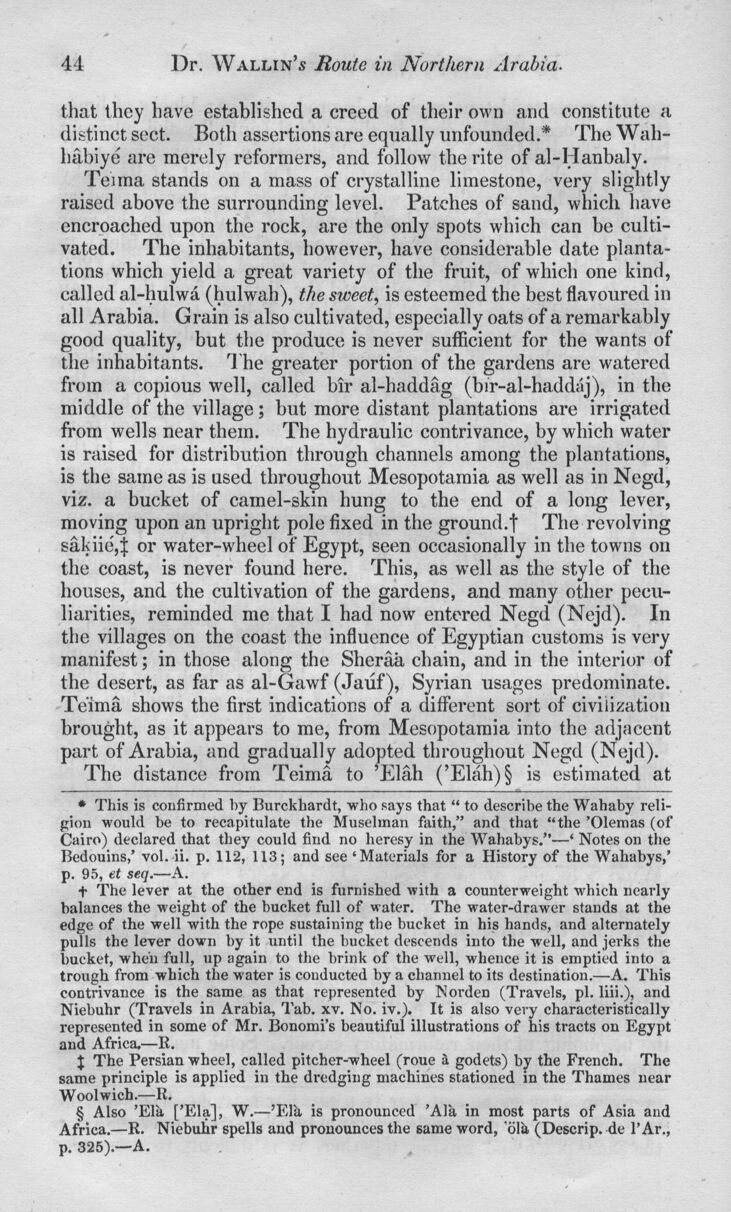
Full resolution (JPEG) - On this page / på denna sida - Route in Northern Arabia

<< prev. page << föreg. sida << >> nästa sida >> next page >>
Below is the raw OCR text
from the above scanned image.
Do you see an error? Proofread the page now!
Här nedan syns maskintolkade texten från faksimilbilden ovan.
Ser du något fel? Korrekturläs sidan nu!
This page has never been proofread. / Denna sida har aldrig korrekturlästs.
[-that-]{+44
Dr. Wallin’s Route in Northern Arabia.
that+} they have established a creed of their own and constitute a
distinct sect. Both assertions are equally unfounded.* The
Wah-habiye are merely reformers, and follow the rite of al-Hanbaly.
Teima stands on a mass of crystalline limestone, very slightly
raised above the surrounding level. Patches of sand, which have
encroached upon the rock, are the only spots which can be
cultivated. The inhabitants, however, have considerable date
plantations which yield a great variety of the fruit, of which one kind,
called al-hulwd (hulwah), the sweet, is esteemed the best flavoured in
all Arabia. Grain is also cultivated, especially oats of a remarkably
good quality, but the produce is never sufficient for the wants of
the inhabitants. The greater portion of the gardens are watered
from a copious well, called blr al-haddag (bir-al-hadd;ij), in the
middle of the village; but more distant plantations are irrigated
from wells near them. The hydraulic contrivance, by which water
is raised for distribution through channels among the plantations,
is the same as is used throughout Mesopotamia as well as in Negd,
viz. a bucket of camel-skin hung to the end of a long lever,
moving upon an upright pole fixed in the ground.! The revolving
sakiie,! or water-wheel of Egypt, seen occasionally in the towns on
the coast, is never found here. This, as well as the style of the
houses, and the cultivation of the gardens, and many other
peculiarities, reminded me that I had now entered Negd (Nejd). In
the villages on the coast the influence of Egyptian customs is very
manifest; in those along the Sheraa chain, and in the interior of
the desert, as far as al-Gawf (Jauf), Syrian usages predominate.
Teima shows the first indications of a different sort of civilization
brought, as it appears to me, from Mesopotamia into the adjacent
part of Arabia, and gradually adopted throughout Negd (Nejd).
The distance from Teima to ’Elah (’Elah)§ is estimated at • * * §
• This is confirmed by Burckhardt, -who says that “ to describe the Wahaby
religion would be to recapitulate the Muselman faith,” and that “the ’Olemas (of
Cairo) declared that they could find no heresy in the Walmbys.”—‘ Notes on the
Bedouins,’ vol. ii. p. 112, 113; and see ‘Materials for a History of the Wahabys,’
p. 95, et seq.—A.
t The lever at the other end is furnished with a counterweight which nearly
balances the weight of the bucket full of water. The water-drawer stands at the
edge of the well with the rope sustaining the bucket in his hands, and alternately
pulls the lever down by it until the bucket descends into the well, and jerks the
bucket, when full, up again to the brink of the well, whence it is emptied into a
trough from which the water is conducted by a channel to its destination.—A. This
contrivance is the same ns that represented by Norden (Travels, pi. liii.), and
Niebuhr (Travels in Arabia, Tab. xv. No. iv.). It is also very characteristically
represented in some of Mr. Bonomi’s beautiful illustrations of his tracts ou Egypt
and Africa.—R.
X The Persian wheel, called pitcher-wheel (roue a godets) by the French. The
same principle is applied in the dredging machines stationed in the Thames near
Woolwich.—II.
§ Also ’Elit [’Ela], W.—’Ela is pronounced ’Alii in most parts of Asia and
Africa.—R. Niebuhr spells aud prouounces the same word, ’olh (Descrip. de l’Ar.,
p. 325).—A.
<< prev. page << föreg. sida << >> nästa sida >> next page >>